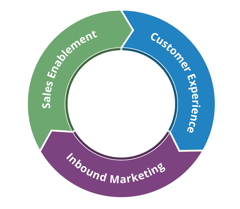"Storytelling is the most undervalued skill in business." So how do you tell a story in a content-heavy marketing world, especially to other businesses? Do people care about your story, or do they care about closing the deal? It turns out people connect more with the cause, more with the meaning, and more with your story than anything else. What is the best way to tell your story in a B2B world?
Step 1: Start with the hardest question first
Why is the message that you are conveying important? What is the motivation behind your story? This is crucial to storytelling in a B2B environment. Organizations that know and understand the “why” factor behind their mission are always the most successful in conveying their message. Those organizations are able to translate their actions and feelings into words, creating a reason why others should take the time to care about the message they are communicating.
Step 2: Present a conflict
Once others understand the "why" component, the second piece of the puzzle is to present the reader with a conflict. Speak about a time when your company was struggling or when it was difficult to satisfy your customers. Every company, no matter the field, goes through periods when the challenges are tough and the decisions are difficult. Engage your listener and find out what piece of your conflict relates to them. This sets your listener up for the final part of your story, where you present your resolution and successful ending.
Step 3: Explain the resolution process
Explain the reasons behind your resolution, and allow your listener to understand the positive outcomes of the conflict fully. Reveal how your successes have helped others and what benefits were gained during the resolution process. As you conclude your story, always capture the passion you’ve been feeling during your conversation or presentation.
Let’s take an example of successful storytelling in B2B and B2C spaces. Howard Schultz, Chairman, and CEO of Starbucks tells a story about how his father ended up with no workers’ compensation or health benefits after being hurt during a work-related accident when he was younger. Schultz said this memory of his father's experience continually stuck with him as he continued to build his company, Starbucks. Schultz revealed that his passion for Starbucks lies in the company’s meaning, people, culture, and mission. Schultz stated, “I’m not as interested in what you make as I am in what you’re passionate about. What business are you really in?” Because of this, Schultz has now ensured that the conflict he saw his father face would not be a conflict that his employees would face. He resolves to ensure the Starbucks culture is consistent with its mission, people, and brand.
How can you successfully master the art of storytelling?
1. Start your story with the “why” factor.
2. Present a conflict your listener can relate to and appeal to their emotions. The point of storytelling is to have a human connection with the reader.
3. End with your resolution, and describe how this helped others. Engage your listener by sharing your passion with them and portraying your successes in a heartfelt manner they can understand.
Storytelling, even in a business-to-business environment, revolves around human connection. You must reach those emotional triggers and portray the meaning behind the product, the pitch, and the company.
We invite you to schedule an inbound marketing consultation where we can discuss your current campaign initiatives, strategy, and the process you have outlined to make sure it's a success.


__Square.png?width=250&height=250&name=Marketing_Hub_(1)__Square.png)




.png?width=250&name=diamond-badge-color%20(1).png)
